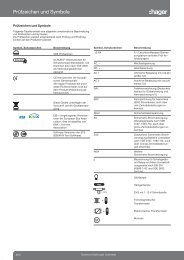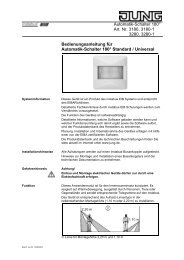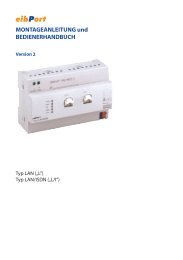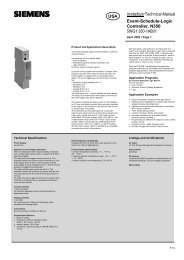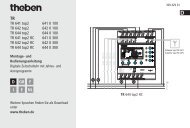Create successful ePaper yourself
Turn your PDF publications into a flip-book with our unique Google optimized e-Paper software.
Detector contact<br />
type / Status<br />
NO contact /<br />
not actuated<br />
NC contact /<br />
Actuated<br />
NO contact /<br />
not actuated<br />
NC contact /<br />
Actuated<br />
NO contact /<br />
Not actuated<br />
NO contact /<br />
Actuated<br />
NO contact /<br />
Not actuated<br />
NO contact /<br />
Actuated<br />
Order-No. 7574 00 1X<br />
Flank reaction in the detector<br />
bus device<br />
Telegram<br />
value<br />
Parameter in the signalling<br />
system<br />
Rising = ON 1 Active on 0 No<br />
Falling = OFF 0 Active on 0 Yes<br />
Rising = OFF 0 Active on 1 No<br />
Falling = ON 1 Active on 1 Yes<br />
Falling = OFF 0 Active on 1 No<br />
Rising = ON 1 Active on 1 Yes<br />
Falling = ON 1 Active on 0 No<br />
Rising = OFF 0 Active on 0 Yes<br />
Table 11: flank evaluation and telegram polarity of a detector telegram<br />
Software "...590101"<br />
Functional description<br />
Detector<br />
triggers<br />
Example: with the setting "Input active on 1" in the detector system, a glass break sensor may<br />
only trigger when there is a glass break and, in this case, the binary input, to which the glass<br />
break sensor is connected, transmits a "1" telegram to the bus.<br />
The sabotage detector must not be created specially. The sabotage input is created independently<br />
of the security areas in the "Signalling system" parameter node as standard and can be<br />
connected to a group address. A fault triggered by a sabotage input has a global effect on all<br />
the areas of the signalling system and requires special acknowledgement (see chapter<br />
4.2.4.12.5. Fault). In addition, the telegram polarity of the sabotage detector input is permanently<br />
predefined and cannot be set. The sabotage input of the signalling system triggers when a<br />
"1" telegram is received via the "Sabotage" object.<br />
i If a detector input has been created in a security area in the ETS plug-in, but has not been<br />
linked to a group address, the plug-in will generate an information message before the panel<br />
is programmed ("Download" command). After the panel is commissioned, detector inputs<br />
without linked group addresses or without a communication partner would cause a fault in<br />
the signalling system, as the detector monitoring would detect a faulty detector input (see<br />
"Detector monitoring" section below).<br />
To prevent function faults in system operation, all the detector inputs created in the plug-in<br />
should also be linked with group addresses and possess a communication partner in the<br />
bus.<br />
Detector list<br />
All the active detectors are displayed in the detector list. The display is opened by pressing the<br />
"Detector list" button on the system page of the signalling system (see picture 35). This allows<br />
easy detection of which detectors are preventing system arming, for example. In addition, it is<br />
easy to see at any time which windows and doors are open in the building.<br />
In addition, missing detectors and a triggered sabotage detector are entered in the detector list,<br />
allowing identification of the cause of a fault.<br />
Page 116 of 222






